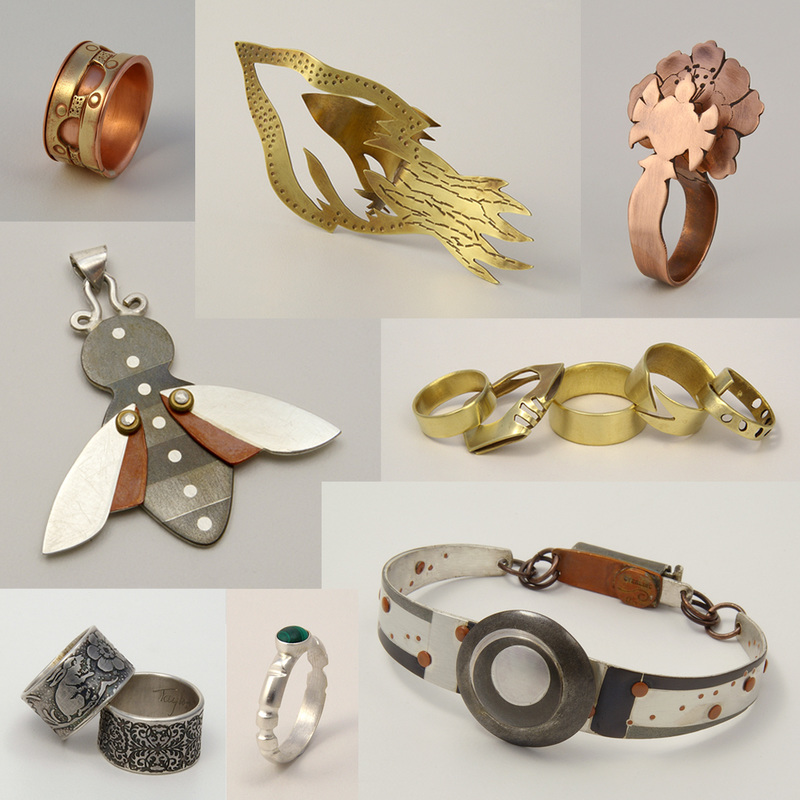 Francesca's first day at Anneville Studio. Francesca's first day at Anneville Studio. I’m very excited to introduce my first intern, Francesca Urciuoli. Francesca is a talented jewelry artist from Perugia, Italy who will be assisting me and advancing her jewelry/metals studies here at Anneville for the next few months. Francesca will be helping out with my classes at Anneville Studio and volunteering at WCCPL, sharing with us her unique skills and outlook. Francesca is fresh from finishing her MFA at the top-ranked metals program at SUNY New Paltz in New York. Before that, she received her BFA in metals from Alchimia in Florence, Italy. Francesca's approach to jewelry focuses on exploring the properties of unconventional jewelry materials such as metals, silicon and fabric. We invite you to a special Friday Night Liberty to help welcome Francesca. Friday, February 5th, 5-9pm. She will be showing her work, and would love to answer your questions about her schools, her work, the difference between American and European jewelry, what it was like to drive across the U.S. from New York to San Diego, and anything else you might have always wanted to ask an Italian jeweler. Word has it she cooks, too! And that she's bringing homemade Italian goodies for us to share. Wow! See some of Francesca's work below, and more on her website.
0 Comments
Recently student Jay M. asked me: Technically there isn't anything you can't do with a direct-drive mill (as opposed to one with reduction) - but reduction gears make life way easier!
Most importantly, reduction gears make it much easier to roll down sheet from one thickness to another, say from 18 gauge to 22 or whatever you like. Mills are designed to do this; really it is their primary purpose. Traditionally you'd melt an ingot, then roll it to the thickness you wanted before you ever got out the jeweler's saw. It is only our 21st century laziness (and convenient online ordering from places like riogrande.com) that have made us order our metal at exactly the thickness we want and relegated the rolling mill to more of a texturing tool. Our mill at school has 7:1 reduction, so you can imagine you'd need a lot more force for the same effect with a direct-drive. Rolling down sheet needs proportionally more force as it gets wider. I'd say rolling down anything wider than 2" would be extremely difficult without reduction. Some direct-drive mills have two handles so you can apply more force (by yourself or with a friend) - that would be handy! So to speak. Oh, and I can't help but add to please never buy a cheap rolling mill ($300 or less, with gear offset from rollers). It will break quickly, but before that it will put horrible waves and distortions in your sheet. Save until you can at least get a Pepe. Or scour ebay and craigslist for a used Durston or Cavallin. Bottom line, for rolling down wire and texturing fairly narrow metal, I think a direct drive is fine. It'll save you $$ and it'll keep you in shape. But if you are planning to roll down sheet on a regular basis, spring for at least 5:1 reduction. Happy rolling! Spring class schedule up at West City - classes start February 8
WCCPL (West City Campus, Point Loma) is a top-notch jewelry/metals lab only about a mile away from Anneville Studio. With a class max of 20 and a large room full of great metals equipment, it is a vibrant and social place to learn. I'll be teaching two classes there this spring. Registration for these classes is through the school, not me! Just follow the links to register. Jewelry and Metalworking - Advanced Mondays, 9am-1pm, Feb 8 - May 23 cost $328 This semester we'll get some time to practice and catch up on techniques introduced previously (marriage of metal, using exotic alloys, shell-forming and vessel fabrication), but we'll start out with a riveted acrylic pendant and some step-bezels for larger art-type cabochon stones. Students new to me are welcome, but you should have basic jewelry/metalworking skills (soldering, sawing, filing, some forming). Register. Jewelry and Metalworking - Beginning to Advanced Mondays, 2-5pm, Feb 8 - May 23 cost $251 Learn the basics or expand your skills while creating three projects. We'll start with an acrylic riveted pendant, move to stone-setting, and finish with a forged silver necklace (silver optional, not included). Beginners are welcome - you'll receive lots of how-to handouts and instructions on purchasing a beginner toolkit on the first day of class. Register. What a fun semester at West City Center, Point Loma. The all-levels class focused on rings - bent, soldered, carved, with stones and without. I was particularly pleased with the creativity of some of the beginners - check out the wearable brass fish ring by Andrea, top center. In the advanced class we worked with bimetals, exotic Japanese alloys, shell-forming and marriage of metals. It was a lot to absorb, but many came up with some amazing projects, especially Julie with her celestial bracelet and Chanalin's bee! The spring advanced class will include some time to catch up and practice the techniques learned in the fall and last spring (vessel fabrication).
|
Anne WolfEducator, metalsmith, jeweler, maker of custom mokume gane jewelry and wedding rings.
Archives
July 2024
|
Home | Rings | Classes | About | Blog | Shop my Etsy Store | Contact | Policies | Join My Mailing List
Top quality, hand-crafted custom mokume gane wedding rings, jewelry and expert mokume gane instruction.
2750 Historic Decatur Road Studio 209 in Barracks 15 San Diego, CA 92106
619-488-7540
2750 Historic Decatur Road Studio 209 in Barracks 15 San Diego, CA 92106
619-488-7540
©2005-2019 Anneville Studio and Jewelry Lab. All rights reserved. 🔨








 RSS Feed
RSS Feed